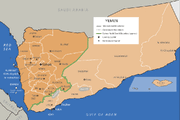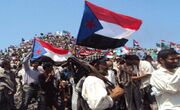| |||||||
| Capital | Aden | ||||||
| Other cities | Al Mukalla, Ash Shihr, Zinjibar | ||||||
| Language official |
Arabic | ||||||
| others | English, Russian, South Arabian | ||||||
| Religion main |
Sunni Islam | ||||||
| others | Hinduism, Judaism, Tribalism | ||||||
| Demonym | South Yemeni, South Yemenite | ||||||
| Government | Unitary semi-presidential constitutional republic | ||||||
| Legislature | Supreme People's Council | ||||||
| President | Yasin Said Numan (YSP) | ||||||
| Independence | from Republic of Yemen | ||||||
| declared | May 21, 1994 | ||||||
| recognized | 1995 | ||||||
| Currency | Dinar (YDD)
| ||||||
| Time Zone | AST (UTC+3) | ||||||
| Calling Code | +969 | ||||||
| Internet TLD | .yd | ||||||
| Organizations | LAS, UN | ||||||
South Yemen (Arabic: اليمن الجنوبي, al-Janub al-Yaman), formally known as the Democratic Republic of Yemen (جمهورية اليمن الديمقراطية, Jumhūrīyat al-Yaman ad-Dīmuqrāṭīyah), is a sovereign state located within the Arabian Peninsula in Western Asia. The nation is bordered by Saudi Arabia to the north, Oman to the east, North Yemen to the west, and maritime borders with Djibouti and Somalia to the south.
The modern day nation began as a series of British colonies which have existed since the 19th century. South Yemen gained independence in 1967, establishing itself as a Communist state backed by the Soviet Union (the only Arab state to have done so). During the final years of the Cold War, South Yemen agreed to unify with the north to become the Republic of Yemen in 1990. Despite its mutual support by Northerners and Southerners, civil war broke out in 1994 at which time South Yemen was able to reachieve independence.
Since the 1990s, South Yemen has emerged as a healthy democracy within the Middle East. The nation has remained economically, militarily, and politically tied with the Soviet Union (including the emulation of the USSR's reforms of the 1990s). The nation has used its oil wealth to help rebuild their aging infrastructure and remains one of the most developed nations in the Middle East. The nation was among the few Arab states to remain peaceful during the Arab Spring in the early 2010s, but border tensions have reemerged following the political uncertainty within North Yemen.
History[]
The first South Yemeni state formed in 1967, with the unification of the Federation of South Arabia and the Protectorate of South Arabia. The People's Democratic Republic of Yemen became the only communist state within the Arab World, and was majorly supported by the Soviet Union.

Location of North Yemen (left) and South Yemen (right).
With the loosening of the Soviet Union during glasnost and perestroika, the proclaimed unification of the PDRY and neighboring Yemen Arab Republic seemed more likely. On May 22, 1990, the two nations united to form the Republic of Yemen. Despite being a united nation, the two sides would continue to strain until civil war breaks out in April 1994. One month later, South Yemen would declare independence as the Democratic Republic of Yemen. Despite attempts by several nations, South Yemen would soon gain support from neighboring Saudi Arabia, offering arms and aid to the southern rebels. By the end of 1994, the war had developed into a stalemate, eventually leading to a UN-backed ceasefire.
In 1995, South Yemen would gain stronger international recognition, helping in securing independence. The ideals of a "Greater Yemen" collapsed, but the government of the Republic of Yemen continued to govern the northern governorates. Unlike earlier relations, tensions between north and south remained strained well until the recently, with the north continuing to claim the south as part of its territory.

South Yemeni flags waving.
During the late 1990's, South Yemen would receive economic and political aid from several nations (primarily the Soviet Union), helping in the rebuilding of the nation. Inspired by the moves of the USSR, the Yemeni Socialist Party oriented itself towards the USSR's political structure, helping to secure democratic reforms within the south. Today, South Yemen is considered the most liberal Arab nation.
During the Soviet-Ethiopian war in Somalia, Aden sent a small number of troops to Somalia, but with most active troops being stationed in the Gulf of Aden. During the Arab Spring of the early 2010s, South Yemen remained internally calm, due in great part to the democratic reforms and economic stability.
Government and Politics[]
The Democratic Republic of Yemen is a unitary state and a semi-presidential republic, with much of the political structure being modeled from the Soviet Union. One of the major political parties within South Yemen is the Yemeni Socialist Party, which has emerged as a social democratic party compared to its communist origins.
The President of South Yemen is democratically elected using a two-round system. The Prime Minister is appointed by the President. The national legislature is the Supreme People's Council.
Demographics[]
South Yemen is formally a secular state, which states the government is to remain neutral in all religious matters. In practice, the majority of South Yemenis are Sunni Muslim, with small populations of Christians, Hindus, Jews, and Shia Muslims.



